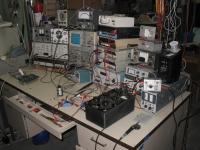Spread Spectrum Capacitive Sensor
I have developed an extremely sensitive capacitive sensor which can detect a person over 1 meter away. It operates using a pseudo-random excitation signal, which is novel for a capacitive sensor. This allows high sensitivity to be achieved in the (inevitable) presence of interfering signals. The sensor also has seven measurement channels, which allow the location and motion of objects to be detected. This sensor was developed primarily to be used in safety systems which detect any people that are close to a car, truck or bus, and might be in danger of being run over. However, the technology could be used in many other ways.
 I developed this on my own time during 2004, working in my home electronics lab. I wanted to play with the capacitive sensor principle, and spread-spectrum appeared to be a novel approach to interference rejection, which was one of the major weakness of past long-range capacitive sensors.
I developed this on my own time during 2004, working in my home electronics lab. I wanted to play with the capacitive sensor principle, and spread-spectrum appeared to be a novel approach to interference rejection, which was one of the major weakness of past long-range capacitive sensors.
This was my effort to make the best capacitive sensor I could within a modest budget. In the end, I came close enough to the ideal sensor that the dominant weaknesses seen in practice are intrinsic in the measurement principle. In particular, minute changes in the near sensor environment such as thermal expansion of the mounting can create capacitance drifts well above the electronic noise floor. For most practical sensing purpose, this design is overkill.
In the process, I came up with some cool hacks that resulted in a simple high-performance design. To me, this was engineering finesse as an end in itself, but it did also result in a system that is highly manufacturable.
